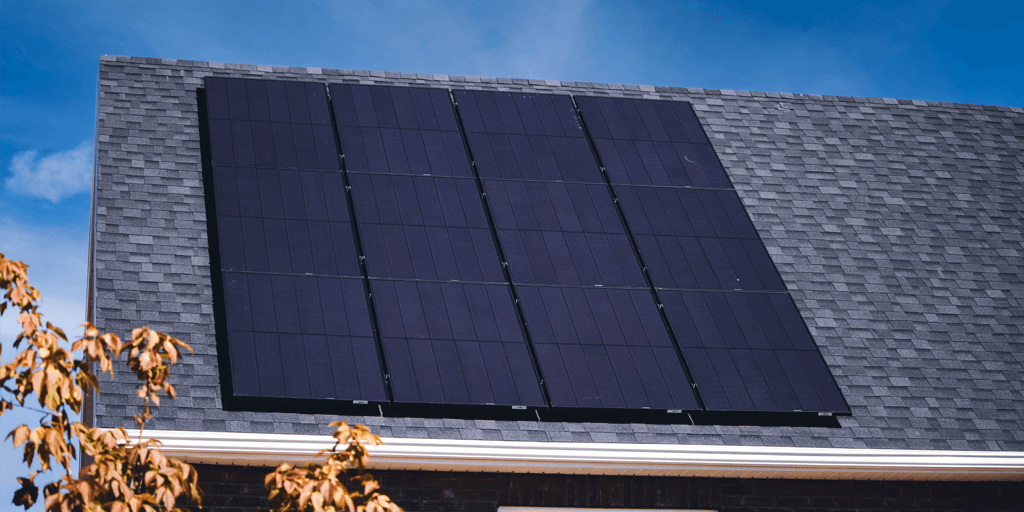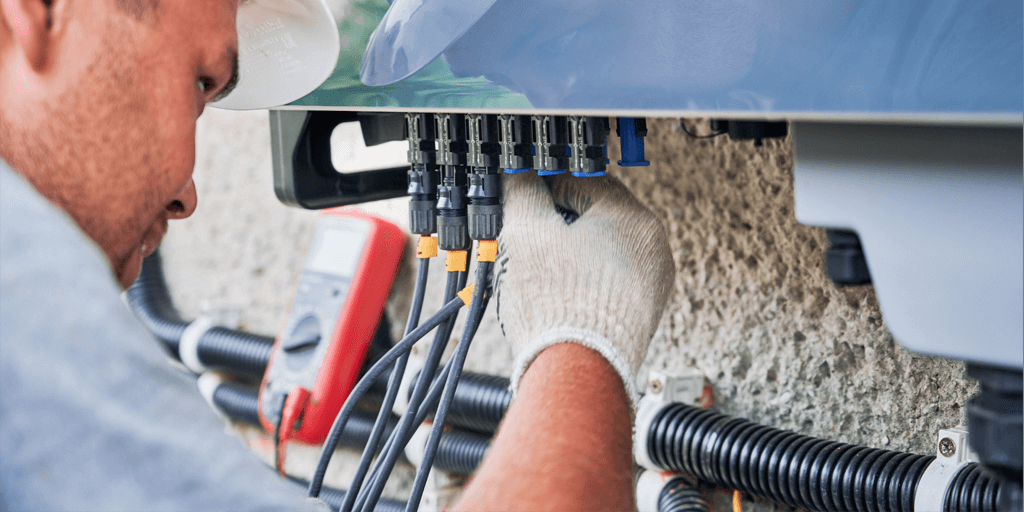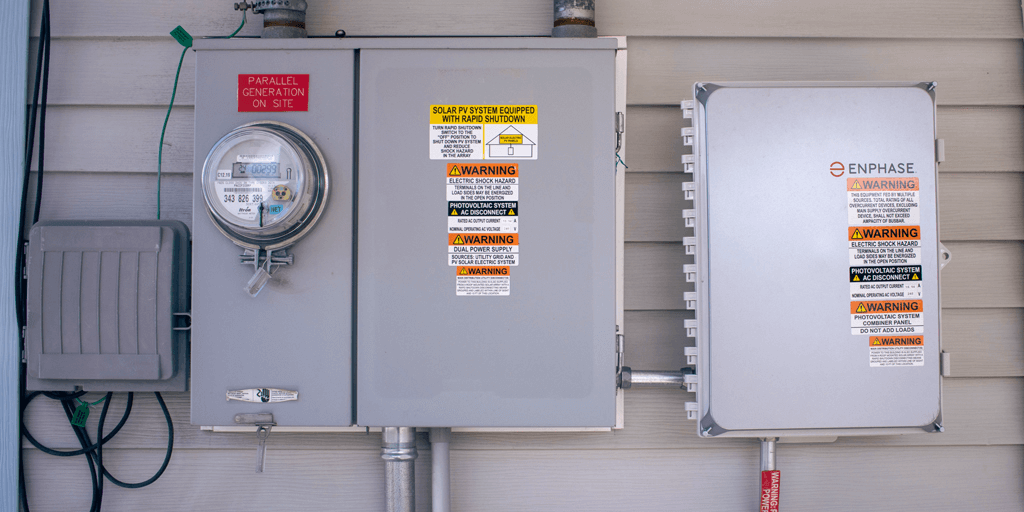
Most homeowners picture a solar system as sleek monocrystalline panels mounted on a roof. It’s easy to overlook the rest of the solar panel system because the components are designed to be resilient, compact, and out of sight.
However, while the solar panels are the most recognized and visible, we contend the inverter is the real star of the show. What role does the inverter play? Are there different types of inverters (yes), and what are the specific advantages and disadvantages of hybrid inverters? We address each of these questions here:

What is a Hybrid Inverter?
Your solar panel system’s inverter is where direct current (DC) electricity generated by your solar panels is converted into alternating current (AC) power—which is the power almost every appliance in your house requires to run. The utility grid also uses AC electricity, so any power from your rooftop system must match to take advantage of benefits like net metering.
There are different kinds of inverters and a hybrid inverter functions as an adaptable hub for converting electricity and managing your solar panel system. Its primary benefit is its ability to convert DC to AC (like all inverters) and convert AC back to DC if you want to adjust your power usage.
For example, most solar battery backups charge via DC power. Solar systems without a hybrid inverter typically have a normal inverter and a battery inverter. In this layout, the electricity is produced by the solar panels, passed through the panel’s inverter to become AC power, and then converted back to DC power by the battery’s inverter before being stored. Not only does this require more equipment, but it also involves more electricity changes—which lowers overall efficiency due to energy loss. However, there are home storage systems, which handle all of the inversion steps at once.
A hybrid inverter provides multiple options to control how your electric charge flows through your solar panel system, including:
- Maintaining the typical format of generating electricity for your home and pushing any excess to the utility grid.
- Diverting a certain amount of electricity to your battery storage before power goes to your home or into the utility grid.
- Pushing a specified amount of electricity to the utility grid for net metering benefits.
- Customizing your power usage based on the time of day and your power needs.
Many hybrid inverters are also capable of working with traditional energy sources, whereas string and microinverters can only work with renewable energy sources. With the right parameters programmed into your hybrid inverter, you can have a tool capable of monitoring your power production, regulating your electricity use, and maximizing your solar system’s efficiency.

Why Doesn’t Everyone Install and Use a Hybrid Inverter?
With all these benefits, why are hybrid inverters not installed with every rooftop solar system? The truth is there are other options, and hybrid inverters have both advantages and disadvantages.
Advantages: Hybrid Inverters are Flexible and Efficient
A hybrid inverter introduces customization to your solar panels while also reducing the number of inversion steps in the power production process. With every conversion, there’s a loss in energy efficiency, and the hybrid inverter optimizes your electricity production.
Disadvantages: Hybrid Inverters are Costly and Complicated
Due to their mechanical complexity and flexibility, hybrid inverters are more expensive than other inverter types. Retrofitting an existing solar system to include a hybrid inverter also incurs additional costs. While hybrid inverters empower you with greater control over your system, this also means there is more to learn about optimizing your settings, creating a steeper learning curve and making hybrid inverters less than ideal if you want to just “set it and forget it.”
Three Common Types of Inverters
Inverters have been used since the 19th century, but when installed with modern solar systems, they are the point of electrical conversion and system monitoring. Today, there are three main options: string/standard inverters, microinverters, and hybrid inverters. Thankfully, your design and installation team will determine the optimal inverter to serve your rooftop system’s needs.
String Inverters
The string, or standard, inverter converts the power for an entire string or row of solar panels (hence the name). Depending on how many panels your system includes, you may have several standard inverters in your system. Each panel produces DC electricity, which then flows into the central inverter which converts it to AC power to run your home. Standard inverters are affordable and straightforward to install.
Microinverters
A microinverter is smaller than a standard inverter and is designed to efficiently convert the energy from a single solar panel. This tends to increase the overall cost, since each solar panel has its own inverter, but it also creates a more flexible solar panel system as a single panel can go down without impacting the performance of the rest of the system. Microinverters are efficient and resilient.
Hybrid Inverters
While they are the most expensive option, hybrid inverters provide homeowners with the most customization. A hybrid inverter is capable of controlling your generated power to your parameters, whether you have solar battery storage or would like increased control over the exact function of your solar panel system. Hybrid inverters are adaptable and maximizing.
Each of these inverters also comes in different sizes, and to ensure optimal system efficiency it’s important for your inverter to fit your system. When you partner with Blue Raven Solar, our team of solar experts will determine what the best type of inverter and size is for you.

What Inverter Option is Best?
Choosing a quality solar installer like Blue Raven Solar gives you access to an expert team who will help you determine the best inverter option for your solar system. We typically install microinverters as they are usually the most cost-effective option to maximize energy production. Microinverters are a great choice when you want a low maintenance system you can “set and forget”—in which case a hybrid inverter may not be the best fit.
At Blue Raven Solar, we always offer a free savings estimate to help you determine if solar is right for you. We use your energy needs, home’s location, and other factors to help you evaluate whether adding solar panels to your home is beneficial, providing an estimate of how much you can save. From there, we will discuss the details and differences which will make your solar system unique to your home and energy needs.
Reach out today to schedule your no-obligation evaluation.



Sorry, the comment form is closed at this time.